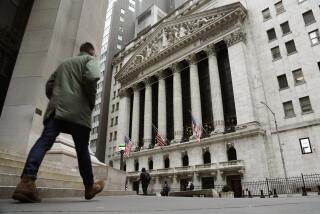GNP Grows; Inflation Up to 6.5% : Economy: An expansion in business investment is signaled. But concerns are expressed over the report showing increase in price levels.
- Share via
WASHINGTON — The nation’s economy rebounded to an annual growth rate of 2.1% in the first quarter after nearly stalling out late last year, but a key measure of inflation surged to a disturbingly high annual rate of 6.5%, the Commerce Department reported Friday.
Economists said the factors influencing the recovery in economic growth--continued trade improvement, a reduction in unsold inventories and expanded business investment--point to more expansion in the months ahead rather than the recession that some had feared.
But they are concerned that the unexpectedly large increase in inflation, as measured by an index tied to the gross national product, could prompt the Federal Reserve Board to step on the brakes by maintaining or perhaps even raising interest rates.
Economist Allen Sinai of the Boston Co. said that “the message is of solid growth in an economy that is poised to keep growing,” tempered by “negative and worrisome” price increases that could force the Fed to dampen future growth.
Inflation, he said, “was entrenched and widespread . . . and that has to be alarming from a policy-making point of view. For the Fed, the growth number is acceptable, but the inflation number must be unacceptable. The question is, how much slower must growth be for inflation to slow?”
“The inflation number,” added Robert G. Dederick, chief economist of the Northern Trust Co. in Chicago, “was absolutely ugly.”
The resumed expansion of the gross national product was well above expectations of only a few weeks ago, when most economists were predicting a sluggish first-quarter GNP report similar to the 1.1% annual growth recorded during the last three months of 1989.
Several components of the first-quarter gain were seen as portents of future economic growth. Business inventories dropped at a yearly rate of $20.5 billion, while business investment gained $9.4 billion, or 7.6%. Both measures reversed course from late 1989, when inventories grew and investment declined.
In addition, the nation’s trade balance improved, and sales of U.S. goods and services expanded both at home and abroad, the Commerce Department reported.
But the upbeat indicators were overshadowed by rising prices.
The 6.5% annual growth rate in the GNP price index, which measures actual price changes for all goods and services that make up the gross national product, was the highest quarterly reading since late 1981. It compares to an inflation rate of 4.5% for all of 1989.
Commerce Department statisticians said that about half of the inflationary acceleration was attributable to temporary energy and food price increases caused by December’s record cold weather. But even excluding the effect of weather and a federal pay raise that went into effect in January, prices still rose at an annual rate of 5.2% during the quarter.
J. Antonio Villamil, the Commerce Department’s chief economist, acknowledged that the inflation report was “disappointing news.” But he said he expects inflationary pressures to moderate later in the year.
The report revived concerns that the Fed would be forced to tighten its grip on the nation’s credit supply at a time when long-term interest rates already have risen above 9% for the first time in a year.
Higher interest rates slow the economy by discouraging businesses and consumers from borrowing money to finance purchases and investments. Interest-sensitive industries such as housing and automobiles can be particularly hard hit.
“We have set ourselves up for a halfway decent first half of 1990,” said Donald Straszheim, chief economist for Merrill Lynch Capital Markets in New York. “But by the end of the year, the economy will be slowing.”
The financial markets were jarred by the inflation report and its potential impact on interest rates. The Dow Jones industrial average fell 31.53 points Friday to close at 2,645.05.
Analyst Giulio Martini at Sanford C. Bernstein & Co. in New York said the Fed will have little choice but to tighten soon because both the economy and inflation are likely to keep rising.
“That’s the reality the Fed has to contend with: a rate of inflation that’s higher than the Fed can tolerate,” Martini said. “I believe the Fed will be waiting to see if the strength we see in the economy here will be ratified later on. If so, the Fed will be forced to act. We already know that 2% growth isn’t slow enough to bring inflation down.”
In a separate report, Commerce Department statisticians said that corporate profits fell by a revised amount of $9.3 billion in the fourth quarter of 1989, a slight improvement from the $9.5 billion decline reported a month ago. Profits fell $12.6 billion in the third quarter last year.
More to Read
Inside the business of entertainment
The Wide Shot brings you news, analysis and insights on everything from streaming wars to production — and what it all means for the future.
You may occasionally receive promotional content from the Los Angeles Times.










